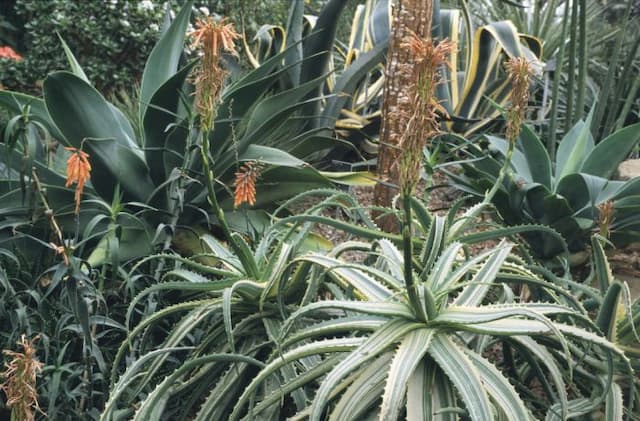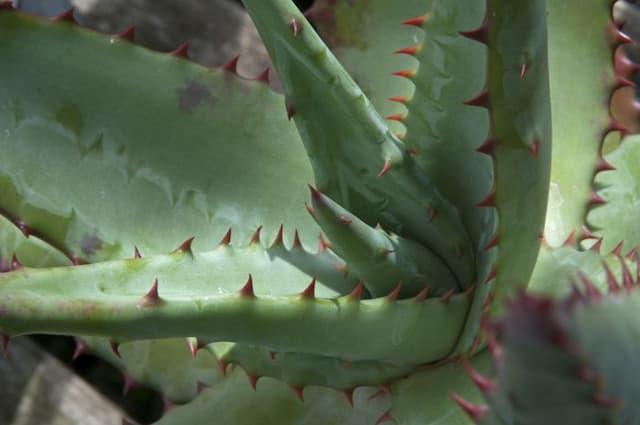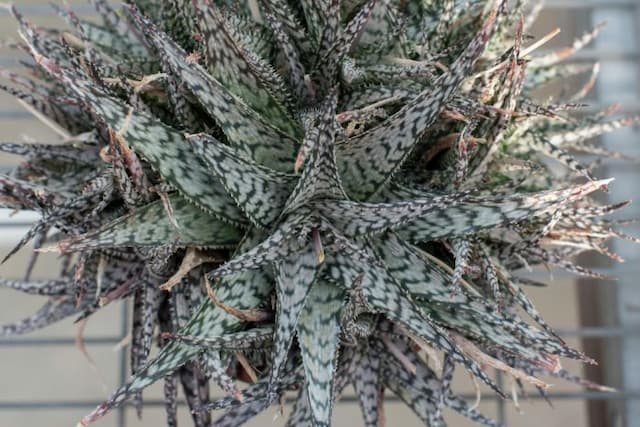Red Hot Poker Kniphofia 'Brimstone' Bloom

ABOUT
Kniphofia 'Brimstone' Bloom, more commonly known as the Red Hot Poker or Torch Lily, boasts a distinctive and striking flower display. The inflorescences are comprised of tubular flowers that closely resemble a fiery torch, hence its common names. These blossoms come in a gradient of colors, ranging from a bright, warm yellow at the base to a burnt orange or reddish hue towards the tip, evoking the image of a flame. The flowers are densely packed onto a sturdy, upright spike that rises above the plant's foliage, making them stand out in the garden landscape. The foliage itself consists of long, slender, and slightly arching leaves that are grass-like in appearance, forming a clump from which the flower spikes emerge. The Red Hot Poker's blooms are particularly favored by hummingbirds and other pollinators, adding an element of wildlife interest to its garden appeal. The striking color transition on the flower spikes provides a bold visual impact and can add a touch of the dramatic to garden borders, beds, or as an accent plant. The unique flowering spikes of Kniphofia 'Brimstone' Bloom have a lengthy period of bloom, ensuring a long-lasting display of color and interest in the garden.
About this plant
 Names
NamesFamily
Asphodelaceae
Synonyms
Red Hot Poker, Torch Lily, Tritoma
Common names
Kniphofia 'Brimstone' Bloom
 Toxicity
ToxicityTo humans
Kniphofia 'Brimstone' Bloom, commonly known as the Red Hot Poker, is not known to be toxic to humans. There are no well-documented cases of poisoning from this plant, and it is generally considered safe in terms of human interaction. However, as with many plants, it may cause mild irritation or an allergic reaction in some individuals if they have sensitive skin or a specific allergy to the plant. Ingesting significant amounts of the plant is not advisable as it is not intended for human consumption and could potentially cause gastrointestinal discomfort due to the presence of saponins or other irritant substances.
To pets
The Red Hot Poker, or Kniphofia 'Brimstone' Bloom, is not widely recognized as a toxic plant to pets. There is little to no substantial evidence suggesting significant toxicity to dogs, cats, or other domestic animals. While it is not listed as a dangerous plant for pets, it is generally recommended to discourage pets from ingesting plants as a precaution. Some animals may experience mild gastrointestinal upset, such as vomiting or diarrhea, if they consume parts of the plant. It would be prudent to prevent pets from chewing on the plant to avoid any potential discomfort or an unforeseen allergic reaction.
 Characteristics
CharacteristicsLife cycle
Perennials
Foliage type
Evergreen
Color of leaves
Green
Flower color
Yellow
Height
3ft (0.91m)
Spread
2ft (0.61m)
Plant type
Herb
Hardiness zones
Varies
Native area
South Africa
Benefits
 General Benefits
General Benefits- Attracts pollinators: The vibrant blooms of the Red Hot Poker serve as a magnet for bees, butterflies, and hummingbirds, enhancing pollination in the garden.
- Drought tolerance: Well-suited to dry conditions, this plant is an excellent choice for xeriscaping and water-wise gardening.
- Low maintenance: Once established, Kniphofia requires minimal care, making it ideal for those with busy schedules or seeking a low-maintenance landscape.
- Seasonal interest: Providing bright, torch-like flowers during the blooming season, it adds striking visual appeal to a garden when many other plants may not be in bloom.
- Deer resistance: The Red Hot Poker is typically resistant to browsing by deer, making it suitable for gardens in areas with deer populations.
- Architectural structure: Its upright form and sword-like foliage can be used to add structure and visual interest to borders and garden beds.
- Long-lasting blooms: The flowers of Kniphofia have a lengthy blooming period, ensuring color in the garden over an extended season.
- Versatility in the landscape: It can be used in a variety of garden styles from cottage to contemporary, making it a flexible choice for garden designers.
 Medical Properties
Medical PropertiesThis plant is not used for medical purposes.
 Air-purifying Qualities
Air-purifying QualitiesThis plant is not specifically known for air purifying qualities.
 Other Uses
Other Uses- Feeding Birds: The Kniphofia 'Brimstone' Bloom, commonly known as Red Hot Poker, produces nectar that attracts hummingbirds and other nectar-feeding birds, providing a natural feeding station in your garden.
- Photography Subject: With its bright, striking flowers, Red Hot Poker can serve as an excellent subject for nature and macro photography, offering vibrant colors and interesting textures.
- Drawing and Painting Inspiration: Artists may use Red Hot Poker as a live model for drawing and painting, capturing its unique form and color in various artistic styles.
- Educational Tool: The plant can be used in educational settings to teach botany and plant physiology, particularly concerning pollination strategies and adaptations.
- Dye Production: The flowers and leaves of Red Hot Poker might be used to produce natural dyes for textiles, though this is less common compared to other plant-based dyes.
- Theme Gardens: Red Hot Poker can serve as a centerpiece or key plant in a fire-themed garden due to its flame-like flower spikes.
- Crafts and Decorations: Dried Red Hot Poker flowers retain some of their color and can be used in floral arrangements, wreaths, and other dried flower crafts.
- Erosion Control: With its clumping growth habit, Red Hot Poker can be planted on slopes or in areas prone to erosion to help stabilize the soil.
- Garden Companion Planting: Red Hot Poker can be paired with plants that have complimentary colors or contrasting foliage to enhance the overall aesthetic of a garden.
- Culinary Garnish: While not commonly used in cooking, the bright flowers of Red Hot Poker may be used as an edible garnish for a dramatic effect on special dishes.
Interesting Facts
 Feng Shui
Feng ShuiThe Red Hot Poker is not used in Feng Shui practice.
 Zodiac Sign Compitability
Zodiac Sign CompitabilityThe Red Hot Poker is not used in astrology practice.
 Plant Symbolism
Plant Symbolism- Attention-grabbing: The vibrant, fiery blooms of the Red Hot Poker make it stand out in any garden, symbolizing the desire to be noticed or the presence of a focal point in one’s life.
- Drama and Impact: With its bold and bright flower spikes, this plant embodies the idea of adding drama or making a significant impact in the environment where it’s placed or within one’s personal experiences.
- Warmth: The warm colors of the Red Hot Poker flowers are reminiscent of fire, and can symbolize warmth, comfort, and the presence of a welcoming atmosphere.
- Strength and Resilience: Red Hot Poker plants are known for their hardiness and their ability to thrive in tough conditions, representing strength, resilience, and the ability to endure challenging situations.
 Water
WaterRed hot poker plants, including the Kniphofia 'Brimstone' Bloom, require consistent moisture but do not like to be overly wet. They should be watered deeply once a week, providing about one gallon of water per plant to ensure the soil becomes moist at root level. During hot and dry periods, increase the frequency to twice a week. In well-draining soil, ensure that the plant is not sitting in water to prevent root rot. When the plant is established, it can tolerate some drought, but it's still important to maintain regular watering for optimal blooming.
 Light
LightRed hot pokers thrive in full sunlight, so place Kniphofia 'Brimstone' Bloom in a spot where it will receive at least six hours of direct sunlight daily. They can also tolerate partial shade, but too little light may reduce flowering. An ideal spot would be in a south-facing or west-facing garden that gets ample sunlight throughout the day.
 Temperature
TemperatureRed hot poker plants, including Kniphofia 'Brimstone' Bloom, prefer warm temperatures and are hardy in USDA zones 5 through 9. They can withstand temperatures as low as 10 to 20 degrees Fahrenheit but thrive best when the temperature range is between 60 and 75 degrees Fahrenheit. Protect them from extreme cold by mulching in the fall, especially in the northern parts of their growing range.
 Pruning
PruningPruning red hot pokers involves removing faded flower spikes to encourage more blooms and maintain plant appearance. Kniphofia 'Brimstone' Bloom should be deadheaded regularly during the blooming season. In late fall, cut back the foliage to about 3 inches above the ground after it dies back. This tidies up the plant and helps prevent disease. Pruning in early spring is also beneficial to remove any old or damaged leaves before new growth starts.
 Cleaning
CleaningAs needed
 Soil
SoilThe Red Hot Poker (common name for Kniphofia 'Brimstone' Bloom) thrives in well-drained soil with a pH range of 6.0 to 6.5. A sandy loam enriched with compost is ideal, providing good drainage and fertility. Incorporating perlite or coarse sand enhances drainage, which is crucial to prevent root rot.
 Repotting
RepottingRed Hot Pokers typically do not require frequent repotting and can be done every 3-4 years or when it is evident that the plant has outgrown its current container, evident by crowded roots or slowed growth.
 Humidity & Misting
Humidity & MistingThe Red Hot Poker prefers moderate humidity levels and is quite tolerant of dry conditions. It does not require specific humidity adjustments when grown in garden settings.
 Suitable locations
Suitable locationsIndoor
Place Red Hot Poker in bright, indirect light; well-draining, loamy soil is best.
Outdoor
Plant Red Hot Poker in full sun, well-drained soil; protect from extreme cold.
Hardiness zone
6-9 USDA
 Life cycle
Life cycleKniphofia 'Brimstone' Bloom, commonly known as Red Hot Poker or Torch Lily, begins its life cycle when seeds are sown or rhizomes are planted during late winter or early spring. Germination follows, with seedlings emerging and growing into juvenile plants with a basal rosette of narrow, grass-like leaves. As the plant matures, it develops a strong root system and foliage mass during its vegetative stage. During late spring to summer, the flowering stage commences with the emergence of tall, sturdy flower spikes topped with tubular, brightly colored flowers that attract hummingbirds and other pollinators. After pollination, seeds are formed and dispersed, while the plant itself may die back partially or go completely dormant in the colder months, depending on the climate. To complete its life cycle, Kniphofia 'Brimstone' Bloom can also propagate vegetatively through division of the clumps every few years in the spring.
 Propogation
PropogationPropogation time
Spring to Summer
The most popular method of propagation for the Kniphofia 'Brimstone' Bloom, commonly known as 'Red Hot Poker' or 'Torch Lily', is by division. The best time to divide this perennial is in the spring or early fall when the plant is not in active bloom. To propagate by division, carefully dig up the entire clump of the plant, making sure to keep a good amount of soil around the roots. Using a sharp spade or knife, split the clump into smaller sections, each with at least one growth point or bud. Replant these divisions immediately, spacing them about 18 inches (approximately 45 centimeters) apart to give each new plant enough room to grow. Water the newly planted divisions well to help establish their roots.









